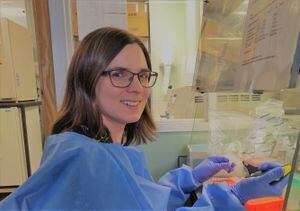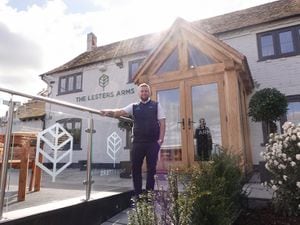Staffordshire scientist joins fight against coronavirus with work on genetic sequencing
A scientist who grew up in Staffordshire has joined an army of researchers working on the genetic sequencing of Covid-19 in the battle against the pandemic.

Dr Charlotte Houldcroft, who attended Lichfield’s Friary School, is one of many volunteers who paused their day-to-day lab jobs to assist in the project, which involves a global team of researchers working in Cambridge.
Dr Houldcroft, from Hammerwich, near Burntwood, started working on virus evolution a decade ago, when she was studying Epstein-Barr virus, which causes glandular fever, during her PHD.
She said: “I’m really interested in viruses which infect normal healthy people without causing any problems, but which can be very serious for anyone who has a weakened immune system, for example after an organ or bone marrow transplant.
"Up until the day before the lockdown, I was working on a project to understand why some kidney transplant recipients develop disease symptoms caused by cytomegalovirus, while others don’t. I’m working to understand what’s different about cytomegalovirus and the immune system of patients who develop diseases versus those who don’t.
"As the epidemic spread I knew sequencing would be needed and I found out on Twitter that Professor Ian Goodfellow would be running the Cambridge sequencing lab, so I volunteered. I stopped my normal job on March 20 and joined the sequencing team the following Monday.
"It was clear that a co-ordinated plan to sequence the pandemic in the UK was needed, including the University of Birmingham, the Glasgow Centre for Virus Research and Public Health Wales, to name just three of the sites involved. We don’t know exactly when Covid-19 became established in the UK, but the sequencing tells us it came in from lots of different sources. There was no single 'patient zero'."
Lockdown brought major changes to people’s lives across the UK, but Dr Houldcroft described her daily routine as more normal than many.
She said: "I go to work in the same building I am normally based in and I work a standard, Monday to Friday week. All the samples I work with are inactivated (safe), so I don’t need special PPE to come to work, and I’m not at any special risk of bringing an infection home to my loved ones. We’re very careful about hand washing and using hand sanitiser when entering or leaving our part of the building.
"Normally I work with cytomegalovirus, and we have very careful safety protocols, like a dedicated lab space, strict hand-washing, gloves and lab coats. All work with the virus has to take place inside microbiological safety cabinets – big glass boxes with protective air flow and built-in UV lights to sterilise everything after we finish work.
Analysis
"Most days are a standard 9-5. Everyone works in teams of two, rotating through different tasks. One day I might be working with Public Health England staff – they are on the floor above our sequencing lab – to pick up inactivated patient samples which then go for sequencing; another day will be more what people imagine goes on in a laboratory – lab coats and gloves, adding patient samples to chemicals which amplify the genetic material of the virus, and then using different enzymes to make the viral genetic material ready to go through the sequencer.
"The most exciting – and nerve-wracking – bit is loading the sample on to the sequencer. The sequencers we’re using are tiny, palm-size Nanopore MinIons and you have to add the sample using a pipette very slowly and gently so that you don’t damage it. Then, over the course of the next two-eight hours, you can watch your samples sequence in real-time, and the data is ready to be shared with everyone who needs to know the results of the analysis – doctors and specialist epidemiologists working in the hospital, as well as scientists nationally who are putting together the big picture of what’s going on in the UK.
"COG-UK is a good name for the project because we’re all playing a small part in something much bigger.
"A lot of scientists have been worrying about – and preparing for – ‘disease X’, a global pandemic, for several years and that preparedness has helped. The project funding some of the research I’m doing now, Network Artic, was put together specifically so that scientists could move fast to study new viral epidemics all over the world – such as Ebola and Zika, and now Covid-19.
"Viruses ‘spill over’ from animals to humans all over the world, all the time. It’s simply an unlucky roll of the dice as to whether that virus can then spread well in humans and cause disease. I don’t think you can put a time on when a pandemic is ‘due’, but the current situation shows us that we need to be prepared to respond when it does."





